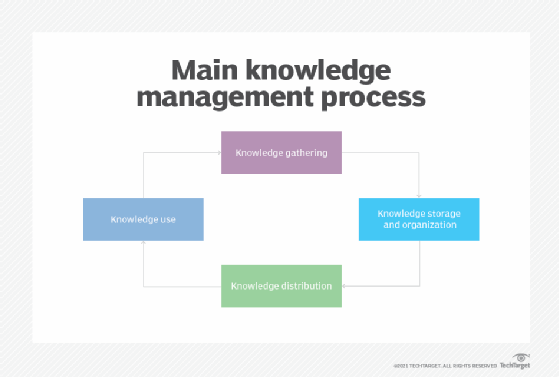
sdecoret - stock.adobe.com
How generative AI can improve knowledge management
With generative AI, knowledge management teams can automate knowledge capture and maintenance processes. Explore how AI can improve knowledge management.
Many organizations struggle to capture knowledge in a timely manner, but generative AI can enhance their efforts.
For decades, knowledge management teams embraced long-form content and subjected articles to lengthy editing and approval processes. However, this approach has become too slow to keep up with the needs of modern enterprises, said Julie Mohr, principal analyst at Forrester Research. To improve the speed at which organizations capture, update and share knowledge, many knowledge management teams have begun to implement generative AI.
What is generative AI?
Generative AI is a type of AI that uses advanced machine learning models, such as transformers, to learn from massive amounts of data.
Developers train these models on trillions of parameters -- pieces of information from books, articles and websites -- to create large language models (LLMs). LLMs power generative AI tools, like ChatGPT and Google Bard, and can generate high-quality text, audio and visual content from natural language prompts.
4 ways generative AI improves knowledge management
Generative AI helps knowledge workers create, find and manage information.
1. Writes articles
Organizations often miss opportunities to capture valuable knowledge because employees don't always have time to write articles for their knowledge base. However, generative AI tools can speed up the writing process, as they can transform bits of information -- such as bullet points or data in a service desk ticket -- into full-length articles.
 Julie Mohr
Julie Mohr
For example, after an IT support technician resolves an incident, generative AI can automatically create a knowledge base article from notes on the technician's ticket, Mohr said.
This automation lets employees like customer service and support agents build up their organization's knowledge base as they take customer calls and resolve tickets. This process leads to more complete knowledge bases, which helps customers and agents resolve problems more quickly in the future.
2. Improves search
A knowledge base should offer an intuitive search function, so users can easily find answers to their questions. The advanced natural language processing capabilities in a chatbot powered by generative AI can match a searcher's intent to the right response more effectively than previous generations of AI chatbots, Mohr said.
Older chatbots and search functions required very specific prompts to return accurate results. Unlike their predecessors, LLMs for generative AI can understand questions written in various ways, and colloquial language and misspellings rarely trip them up.
Additionally, generative AI tools can pull answers from specific sections, paragraphs and sentences within lengthy articles and present them to users in a conversational style.
"It's not surfacing a bunch of knowledge articles and saying, 'Here are a bunch of responses that might work.' It searches in those and says, 'Oh, here's the answer to the question … And oh, by the way, here's the link to where we found that information,'" Mohr said.

3. Identifies knowledge gaps and duplicates
Even large, comprehensive knowledge bases can lack answers to important questions. Generative AI's ability to quickly analyze large volumes of information can help organizations identify these gaps, so subject matter experts (SMEs) can address them, Mohr said.
For instance, multiple customers might search their CRM provider's self-service portal to learn how to resolve a particular issue. The provider's generative AI tool can quickly analyze all the company's knowledge articles for that answer. If it cannot find a match, it can flag the topic and alert the most appropriate SME.
Generative AI can also help organizations identify duplicate articles, Mohr added. Duplicate articles -- which address the same topic or problem -- in a knowledge base can confuse users, as they don't know which version contains the most up-to-date information. Generative AI can analyze articles and detect those that cover the same issue, even if duplicates use different wording and formatting.
4. Automates governance processes
Organizations often have governance teams manually check knowledge articles before publication to ensure they don't contain personally identifiable information. Generative AI can automate and speed up this process, Mohr said.
"Instead of having a person check, … the [AI tool] itself is applying an engineered prompt that looks at … anything with a social security number structure or a phone number structure … and then it would flag that and say, 'No, this cannot be published until someone looks at it,'" Mohr said.
Articles that pass the automated governance check can skip the manual review process, which helps organizations make knowledge available more quickly.
Is AI hallucination a concern in knowledge management?
After ChatGPT's public launch in 2022, users noticed the tool often gave them inaccurate responses to questions, also known as AI hallucinations. These responses can sound credible and include a lot of detail, but still have no factual basis to support them.
The potential for hallucinations should concern anyone who plans to use generative AI, but the problem occurs most often when the users prompt the tool to write about general knowledge. For example, a marketer for a vitamin company that uses generative AI to write blog posts on broad nutrition topics can expect to encounter hallucinations because the websites where LLMs get information may contain conflicting or outdated information on the subjects.
However, generative AI in knowledge management requires organizations to train the tools on their own internal knowledge, which reduces the risk of hallucination.
"When you're talking about doing internal knowledge management, you're using a pre-trained model on a large corpus of information, and you're … fine-tuning that training with your data. … If you get hallucinations, … it's probably because you have out-of-date knowledge," Mohr said.
Organizations with incomplete and outdated knowledge can expect to experience hallucinations until they flesh out and update their content.
How should knowledge management teams implement generative AI?
To implement generative AI in knowledge management, organizations can wait for a vendor they already use to add generative AI functionality to their offering, Mohr said. For example, many IT service management, CRM, customer service and enterprise content management vendors have already begun to add generative AI features, which organizations can use to improve knowledge management.
Organizations can also build their own LLMs to save money in the long term, but this approach requires them to retain highly skilled employees in a competitive landscape.
"I've been looking at salaries … for anybody that knows anything about generative AI and they're not just six figures. They're double six figures or triple six figures … It's going to be very hard to train and retain staff," Mohr said.
Organizations that choose to build their own LLMs must heavily invest in employee training and prepare for high attrition rates. For most organizations, existing vendors offer the simplest generative AI implementation method.







